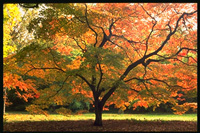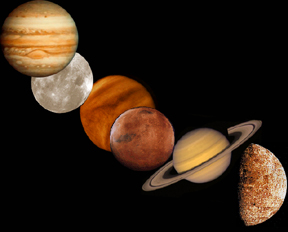In mid-May, Jupiter, Venus, Mars, Saturn and Mercury will join the Moon in the sky. This image represents the order in which you will see these bodies around May 13th from high to low in the sky: Jupiter, the Moon, Venus, Mars, Saturn and then Mercury. Please note: planet sizes are not meant to be to scale.
Click on image for full size
Windows to the Universe original image
Planetary Alignment 2002
News story originally written on April 24, 2002
In late April through mid-May 2002, all five naked-eye
planets are visible simultaneously in the night sky! This is includes
Mercury which is generally very hard to see because of its proximity to
the Sun. You won't want to miss this! The next similar gathering of these five planets won't occur until September 2040!
Use the links below to find out specific viewing information for specific dates.
You might also be interested in:

It was another exciting and frustrating year for the space science program. It seemed that every step forward led to one backwards. Either way, NASA led the way to a great century of discovery. Unfortunately,
...more
The Space Shuttle Discovery lifted off from Kennedy Space Center at 2:19 p.m. EST, October 29th. The sky was clear and the weather was great as Discovery took 8 1/2 minutes to reach orbit for the Unitied
...more
A moon was discovered orbiting the asteroid, Eugenia. This is only the second time in history that a satellite has been seen circling an asteroid. A special mirror allowed scientists to find the moon
...more
Will Russia ever put the service module for the International Space Station in space? NASA officials are demanding an answer from the Russian government. The necessary service module is currently waiting
...more
During a period of about two days in early May, 1998, the ACE spacecraft was immersed in plasma associated with a coronal mass ejection (CME). The SWICS instrument on ACE, which determines unambiguously
...more
J.S. Maini of the Canadian Forest Service has referred to forests as the "heart and lungs of the world." Forests reduce soil erosion, maintain water quality, contribute to atmospheric humidity and cloud
...more
In late April through mid-May 2002, all five naked-eye planets are visible simultaneously in the night sky! This is includes Mercury which is generally very hard to see because of its proximity to the
...more














